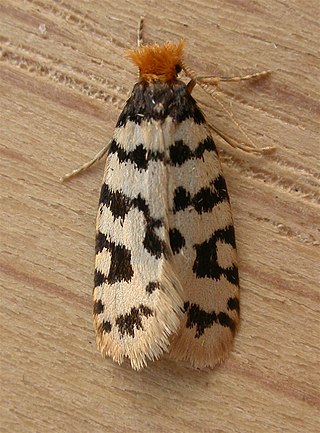
The Psychidae are a family of the Lepidoptera. The bagworm family is fairly small, with about 1,350 species described. Bagworm species are found globally, with some, such as the snailcase bagworm, in modern times settling continents where they are not native.

The Ditrysia are a natural group or clade of insects in the lepidopteran order containing both butterflies and moths. They are so named because the female has two distinct sexual openings: one for mating, and the other for laying eggs.
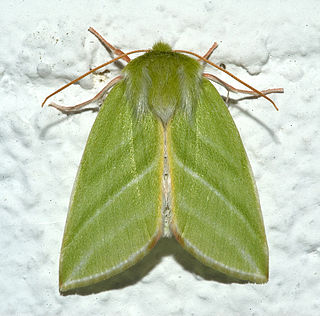
Nolidae is a family of moths with about 1,700 described species worldwide. They are mostly small with dull coloration, the main distinguishing feature being a silk cocoon with a vertical exit slit. The group is sometimes known as tuft moths, after the tufts of raised scales on the forewings of two subfamilies, Nolinae and Collomeninae. The larvae also tend to have muted colors and tufts of short hairs.

Yponomeutoidea is a superfamily of ermine moths and relatives. There are about 1,800 species of Yponomeutoids worldwide, most of them known to come from temperate regions. This superfamily is one of the earliest groups to evolve external feeding and to colonize herbs in addition to shrubs and trees.

Gelechioidea is the superfamily of moths that contains the case-bearers, twirler moths, and relatives, also simply called curved-horn moths or gelechioid moths. It is a large and poorly understood '"micromoth" superfamily, constituting one of the basal lineages of the Ditrysia.
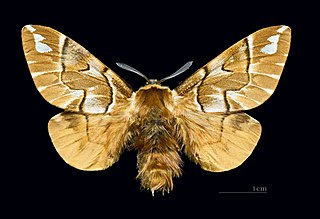
Endromidae is a family of moths consisting of 16 genera with 72 species. This relictual family is related to the families Carthaeidae, Anthelidae, and Phiditiidae as part of the bombycine group “CAPOPEM”.
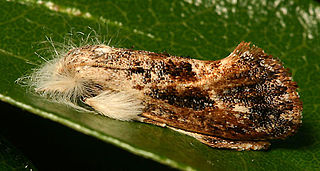
Acrolophinae is a family of moths in the order Lepidoptera. The subfamily comprises the burrowing webworm moths and tube moths and holds about 300 species in five genera, which occur in the wild only in the New World. It is closely related to the family Tineidae.
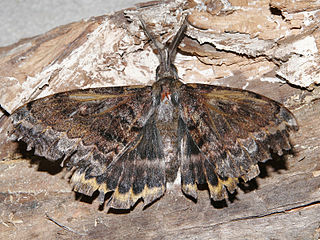
Anthelidae is a family of Australian lappet moths in the order Lepidoptera. It had earlier been considered to be part of the Lasiocampoidea superfamily, but a 2008 molecular phylogenetic study, supported by a 2011 study, resulted in reincluding the Anthelidae in the superfamily Bombycoidea.
Acanthopteroctetidae is a small family of primitive moths with two described genera, Acanthopteroctetes and Catapterix, and a total of seven described species. They are known as the archaic sun moths.

The insect order Lepidoptera consists of moths, most of which are night-flying, and a derived group, mainly day-flying, called butterflies. Within Lepidoptera as a whole, the groups listed below before Glossata contain a few basal families accounting for less than 200 species; the bulk of Lepidoptera are in the Glossata. Similarly, within the Glossata, there are a few basal groups listed first, with the bulk of species in the Heteroneura. Basal groups within Heteroneura cannot be defined with as much confidence, as there are still some disputes concerning the proper relations among these groups. At the family level, however, most groups are well defined, and the families are commonly used by hobbyists and scientists alike.

Cimeliidae, the gold moths, is a family of moths that is now placed in the macroheteroceran superfamily Drepanoidea, although previously placed in its own superfamily. Uniquely, they have a pair of pocket-like organs on the seventh abdominal spiracle of the adult moth which are only possibly sound receptive organs. They are quite large and brightly coloured moths that occur in southern Europe and feed on species of Euphorbia. Sometimes they are attracted to light. The family was first described by Pierre Chrétien in 1916.

The Obtectomera is a clade of macro-moths and butterflies, comprising over 100,000 species in at least 12 superfamilies.

Praydidae is a family of false ermine moths in the superfamily Yponomeutoidea. Though once considered a subfamily (Praydinae), a 2013 molecular analysis elevated it to family rank.
Falcogona is a genus of moths of the family Endromidae. It contains only one species, Falcogona gryphea, which is found in Vietnam.
Pseudandraca is a monotypic moth genus of the family Endromidae erected by Tamotsu Miyata in 1970. The genus was previously placed in the subfamily Prismostictinae of the family Bombycidae. Its only species, Pseudandraca gracilis, was described by Arthur Gardiner Butler in 1885. It is found in Japan.

Oberthueria is a genus of moths of the Endromidae family. The genus was previously placed in the subfamily Oberthueriinae of the Bombycidae family.

Phiditiidae is a family of moths. The family used to be placed as a subfamily (Phiditiinae) in the family Bombycidae.
Tridentaforma is a genus of moths of the Tridentaformidae family, the sole genus of the family. There is only one species in the genus, Tridentaforma fuscoleuca, which is found in California and Canada.
The Macroheterocera are a well supported clade of moths that are closely related to butterflies and macro-moths.













